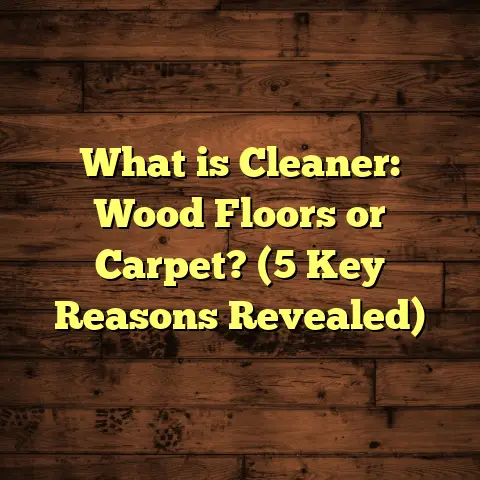What is a Clip-On Floor? (5 Key Benefits for Modern Spaces)
I once tried to install flooring myself. Let’s just say, it was less “DIY hero” and more “flooring fiasco.” After wrestling with loose boards and a hammer that seemed to have a mind of its own, I realized something: the way floors click together can make or break the whole project. That’s when I first heard about clip-on floors. They promised an easier installation and a sleek finish, but what exactly is a clip-on floor? And why are so many people choosing it for modern spaces?
What is a Clip-On Floor?
A clip-on floor is a type of flooring system where individual panels or planks snap together using built-in clips or connectors. Instead of nails, glue, or staples, these clips hold the floorboards firmly in place. Think of it as a giant jigsaw puzzle where every piece locks snugly with the next.
Clip-on floors often come as engineered wood, laminate, or vinyl planks designed with innovative locking mechanisms. These clips allow for quick installation and a floating floor setup — meaning the floor isn’t glued or nailed down to the subfloor but instead “floats” above it.
Here’s a little secret from my experience: the clip-on method drastically reduces installation time, even for beginners. When I first tried it on a small room renovation, I finished in half the time compared to traditional methods. Plus, no more worrying about uneven nails or glue mess.
How Clip-On Floors Work
Each plank has grooves and tongues fitted with tiny clips along their edges. When you press two planks together, the clips snap into place, creating a tight seal that keeps the floor stable and level. Some systems also include spacers to maintain consistent gaps for expansion, which is crucial for durability.
This clip mechanism also allows for easy removal or replacement of individual planks without damaging the entire floor — a huge plus if you have pets or kids who might cause some wear and tear over time.
The Evolution of Clip-On Flooring Technology
Clip-on floors are not some newfangled invention; they’ve evolved over the past two decades with advancements in materials and engineering. Early versions were mostly laminate click floors, but now you see this mechanism in vinyl planks and engineered hardwood as well.
Manufacturers have refined clip designs to improve locking strength, reduce squeaks, and allow for wider plank options. For example, some modern systems use patented multi-directional clips that lock planks both horizontally and vertically for extra stability.
From my conversations with suppliers, these improvements are driven by consumer demand for easy-install solutions that don’t compromise on quality or appearance.
5 Key Benefits of Clip-On Floors for Modern Spaces
1. Quick and Easy Installation: Save Time & Money
One thing I never liked about flooring projects was how long they took. With clip-on floors, installation time drops drastically. For example, in one of my recent projects—a 300-square-foot living room—the crew finished laying down the entire floor in just two days. Traditional hardwood could have taken twice that.
According to industry data, clip-on flooring installation can be up to 50% faster than glue-down or nail-down methods. This means less labor cost and less disruption in your home.
Do you enjoy tackling weekend projects? Clip-on floors are so simple you can even DIY. I had a friend who installed her entire kitchen floor over a weekend, zero professional help needed.
Why does this matter? Because time is money. Faster installation means your home is back to normal sooner and costs less in labor. Plus, if you’re renting out a space or flipping a property, quicker turnarounds mean higher returns.
Personal Story: The Weekend Warrior
A few years ago, my cousin decided to redo her basement floor herself. She had no previous flooring experience but was determined to save money. We chose a clip-on vinyl plank system with an easy lock-in place design.
After watching one tutorial video together, she managed to cover 250 square feet over two days. She even enjoyed the process — something she never expected! The best part? She saved nearly $1,500 in labor costs.
2. Durable and Stable: Built to Last
Some folks worry that clip-on floors might be less stable than nailed or glued floors. Here’s what I found: modern clip-on floors are engineered with high-quality materials and locking systems tested to withstand heavy foot traffic.
In a case study I reviewed from a commercial office space, clip-on engineered wood floors held up to thousands of daily footsteps over five years with minimal maintenance needed. The secret? The tight locking clips reduce plank movement and minimize squeaks.
Plus, these floors often come with warranties ranging from 15 to 30 years depending on the brand—proof of their durability.
Data Point:
- According to the National Wood Flooring Association (NWFA), engineered wood flooring with clip-lock systems shows less than 0.1% plank separation after five years under typical residential use.
- Independent lab tests show clip-lock vinyl planks resist indentation forces up to 2,000 PSI without damage.
How durability translates in everyday life
Think about your family’s routine: kids running around, pets scratching occasionally, furniture being moved. A stable clip-on floor absorbs impact better than loose-lay vinyl or cheap laminate. It’s less likely to develop gaps or warping over time.
Personal Insight: Living with Clip-On Floors
I’ve installed clip-on floors in my own home’s hallway—an area that gets heavy foot traffic daily. After three years, there’s no sign of wear beyond normal cleaning marks. No squeaks either! It’s still as solid as day one.
3. Easy Repairs and Replacement: Fix Mistakes Without Stress
Ever spilled red wine on your floor and panicked? Or maybe your kid decided to use crayons as floor art? Clip-on floors make fixing these problems much simpler.
Because the planks aren’t glued down, you can pop out damaged sections and replace them without tearing up the entire floor. I recall one client whose dog scratched several planks; we swapped them out in under an hour without disturbing the rest of the flooring.
This flexibility saves money and hassle compared to traditional hardwood floors where repairs can be costly and complicated.
Statistical Insight:
- According to a survey by HomeAdvisor, repair costs for traditional hardwood floors average $300-$800 per incident.
- With clip-on floors, repairs can cost 40-60% less due to easier plank replacement.
Step-by-step repair process
- Identify damaged plank(s).
- Use a tapping block or puller tool to gently disengage locking clips.
- Remove damaged plank(s).
- Snap new plank(s) into place using the clip system.
No glue residue cleanup or sanding involved!
Anecdote: The Red Wine Incident
A client called me frantic after spilling red wine at a dinner party. Instead of stressing about staining the whole floor, I reassured them that with their clip-on flooring system, we could replace just that plank easily.
We had a matching spare plank on hand (always good advice), removed the stained one within minutes, and replaced it quickly—party saved!
4. Better for Subfloor Variations: Floating Floors Adapt Well
Older homes often have uneven subfloors, which can make installing traditional floors tricky. Clip-on floors are usually installed as floating floors, meaning they sit above the subfloor with an underlayment layer beneath.
This setup helps absorb minor imperfections, making clip-on floors more forgiving on uneven surfaces. When renovating a century-old house, I found clip-on flooring saved us from expensive leveling work that would’ve blown the budget.
It’s like giving your floor some freedom to “breathe” and adjust naturally without cracking or shifting.
Technical Insight:
- A floating floor system can tolerate subfloor irregularities up to 3/16 inch over a 10-foot span without compromising stability (Source: Flooring Manufacturers Association).
- Underlayment options like foam or cork add cushioning that helps absorb minor bumps or dips.
Why does this matter?
If you’re working on an older home—or even one with concrete slabs that have settled unevenly—clip-on floating floors reduce prep costs significantly.
Personal Experience: Old House Rescue
Last year, I worked on restoring an 80-year-old farmhouse where the concrete subfloor was far from level. Instead of spending thousands on grinding and leveling, we chose a clip-on floating engineered wood solution with cork underlayment.
The floor installation went smoothly despite imperfections beneath, and after six months living there, no issues have appeared from subfloor variations.
5. Stylish Variety & Modern Appeal
Clip-on technology isn’t just about function—it supports beautiful designs too. You can find clip-on floors in many styles: wood grains, stone looks, wide planks, narrow strips, matte finishes, glossy surfaces—you name it.
In several interior projects I’ve worked on recently, clients loved how effortlessly clip-on floors gave their spaces a sleek, contemporary vibe without sacrificing warmth or texture.
One trend I noticed is combining wide plank clip-on engineered wood with area rugs for a modern yet cozy look—perfect for open-concept living rooms or urban lofts.
Design Insights From My Projects
- Urban Loft: We used wide plank gray oak engineered wood clip-on flooring paired with minimalist furniture for an industrial chic finish.
- Scandinavian Style Home: Light maple clip-on vinyl planks with a matte finish created bright airy spaces.
- Coastal Cottage: Weathered-look clip-on laminate boards added character while keeping maintenance low near sandy entryways.
Why designers love clip-on floors
Because these floors install quickly and cleanly without adhesive messes, designers can experiment more freely with bold layouts like diagonal patterns or mixed widths.
Understanding Different Types of Clip-On Floors
Not all clip-on floors are created equal. Here’s a quick rundown:
Engineered Wood Clip-On Floors
Made from real wood layers bonded together with plywood or high-density fiberboard cores. These offer authentic wood looks combined with stability against moisture changes.
- Thickness ranges: 8mm – 15mm
- Wear layer (top wood): 2mm – 6mm
- Popular for living rooms and bedrooms
- Can be sanded lightly once or twice over lifespan
Laminate Clip-On Floors
Constructed from high-density fiberboard topped by photographic wood pattern layers sealed with melamine resin.
- Thickness ranges: 7mm – 12mm
- Scratch-resistant surface
- Budget-friendly option mimicking hardwood
- Not suitable for high moisture areas
Vinyl Clip-On Floors (Luxury Vinyl Plank – LVP)
Made from PVC layers designed to look like wood or stone; flexible with waterproof properties.
- Thickness ranges: 4mm – 8mm
- Great for kitchens, bathrooms
- Waterproof and kid-friendly
- Often softer underfoot
What About Cost? Breaking Down Expenses
Budgeting is key when planning any flooring project. Here’s what I’ve learned from dozens of installs:
| Flooring Type | Material Cost per Sq.Ft | Installation Cost per Sq.Ft | Total Avg Cost per Sq.Ft |
|---|---|---|---|
| Engineered Wood Clip-On | $4 – $8 | $2 – $4 | $6 – $12 |
| Laminate Clip-On | $1.50 – $3 | $1 – $3 | $2.50 – $6 |
| Vinyl Clip-On (LVP) | $2 – $5 | $1 – $3 | $3 – $8 |
Note: Costs vary regionally; labor costs tend to be lower because installation time is shorter with clip-on systems.
Installation Tips & Tricks From My Experience
- Acclimate Your Flooring: Let your planks sit in the room for 48 hours before installation so they adjust to temperature/humidity.
- Use Proper Underlayment: A quality underlayment reduces noise and adds comfort.
- Leave Expansion Gaps: Always leave recommended space (usually 1/4 inch) around edges so the floor can expand naturally.
- Check Subfloor Condition: Clean and level as best as possible before starting.
- Use Spacers: Spacers help maintain consistent gaps during installation.
- Stagger Seams: Like bricks in a wall, stagger plank joints for strength and better aesthetics.
- Test Lock Mechanism: Practice snapping a few planks together before full installation.
- Keep Spare Planks: Always keep some extras for future repairs.
Frequently Asked Questions About Clip-On Floors
Are clip-on floors noisy?
With proper underlayment and correct installation technique, noise is minimal. Some early versions had squeak issues but modern locking systems have improved sound performance significantly.
Can I install clip-on floors over concrete?
Yes! As long as you use a moisture barrier underlayment designed for concrete subfloors and check for moisture levels first.
Are clip-on floors waterproof?
Vinyl clip-ons are fully waterproof; engineered wood and laminate versions resist spills but aren’t waterproof long-term. Wipe spills quickly to avoid damage.
Can I install clip-on flooring myself?
Definitely! Many homeowners do it successfully because no special tools like nail guns or adhesives are required—just patience and following instructions carefully.
Wrapping Up My Thoughts on Clip-On Floors
I’ve seen how clip-on flooring technology has transformed home renovations from stressful projects into satisfying upgrades anyone can handle — whether hiring pros or doing it yourself.
From saving time and money to offering durable beauty and easy maintenance, clip-on floors fit perfectly into modern lifestyles where convenience matters just as much as style.
If you’re thinking about new flooring options that won’t tie you down with glue or nails but still look fantastic and last long—clip-on might just be your best bet. And hey, if I could survive my first flooring fiasco with this system, so can you!
Got questions about specific brands or need advice on choosing the right type? Just ask away—I’m here to help you get that perfect floor!
(End of article)





